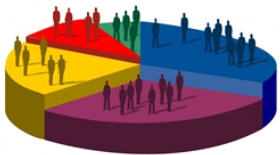|

|
Why B2B SMEs need to segmentize customers
|
|

|
|
| Top Stories |
 |
|
|
|
Writuparna Kakati | 05 May, 2009
Sales in any business are most frequently generated through business relationships it establishes. As a business owner, the better you can manage these relationships, the more success you will grab. But to do that, you need to segmentize your customers to understand their needs better. It helps targeting your potential customers with appropriate offers and sell to them more.
What are the benefits of segmenting your customers? It helps to increase your customer service efficiency. When you keep a well organized record of your customer details and sales, you can speed up the transactions with less error and more reliability. Plus, you get that time to customize your product offerings. In addition, customer profiling also boosts the planning process; you can forecast who needs what and how much from your business.
So, how to profile your customers? It solely depends on the type of business you are engaged into. If your SME (Small and Medium Business) sells only to individual customers, you need to analysis their tastes, habits, lifestyle and their purchase cycle. A little analytics about the age group of your customers, their earning capability and buying behavior can help you a lot to know about the potential customers in B2C (Business to Customer) marketing. But when it comes to customer segmentation in B2B (Business to Business), it is not so easy to identify the customers into some distinct categories and fine-tune product and pricing strategies accordingly to achieve the maximum impact.
In B2B (Business to Business) transaction, profiling customers becomes much more difficult as compared to that in B2C marketing. It is primarily because, as a B2B marketer, you will hardly find enough market data to analysis your customer base. And even if you get enough market data, it is hardly possible in B2B marketing to find out exactly why one of your competitors has lost a client and why another one has won the client. Plus, it is very difficult in a B2B environment to win a competitive advantage as there remains little or no difference from one product to another.
Therefore, SME B2B marketer need to devote more time and effort to customer profiling. As a business dealing with other businesses, you need to analysis the needs of your existing and potential customers, and also what your competitors are doing. In B2C marketing, customer segmentation aims at identifying customers who have a high disposition for a product. Similarly, in B2B marketing, a business needs to identify clusters of like-minded companies.
B2B customers have more complicated needs and therefore need-based segmentation can be very difficult for B2B enterprises. It is why many business-to-business marketers like to segment their customers merely on the basis of their location while some others prefer segmentation based on company size (small, medium, big). Another approach called 'predictive segmentation' has also become popular in these days where customer segmentation is done based on expectation how customers are to respond in the future to pricing, channels, or other aspects of business.
So what to consider while segmenting your B2B customers:
- The starting point should always be a good database. The database must contain contact details of the customers together with their purchase history (in case of customers you have already served) .
- Now, it must be determined the needs of every company on your database. Why a particular company buys from you? Is it because your products are cheap? Or is it because of your products' technical excellence? Or does a company buys from you primarily because of your prompt delivery? Answering a few such questions can help you a lot segmentize your customers in a better way.
- Finally, you should do some more research to find out whether there are some common trends based on which you can segmentize your customers into some specific clusters. In this process, you should try to limit the number of clusters to a manageable number.
- While segmenting your customers, be careful that the segments are distinct from on another and none of the listed companies fall into more than one segment. You may consider dividing the buyers into some distinct groups such as small or big, price seekers or delivery buyers, and so on.
In business to business marketing, customer segmentation is a crucial step. When you group your customers into some distinct segments, each with some common needs and expectations, it becomes easy to set your objective more intelligently. Once the objectives have been set, you can design your product, price, promotion strategies keeping in mind specific requirements of each of your target customer segments to provide all of them with more value. That's not all, segmenting your customers can also help finding out a niche market for your business with segments are not well covered at the moment and overlooked by competitors till now.
|
|
|
| |
|
|
|
|
|
|
|
|
|
|
|
|
|
|
| |
| Customs Exchange Rates |
| Currency |
Import |
Export |
US Dollar
|
84.35
|
82.60 |
UK Pound
|
106.35
|
102.90 |
Euro
|
92.50
|
89.35 |
| Japanese
Yen |
55.05 |
53.40 |
| As on 12 Oct, 2024 |
|
|
| Daily Poll |
 |
 |
| Do you think Indian businesses will be negatively affected by Trump's America First Policy? |
|
|
|
|
|
| Commented Stories |
 |
|
|
|
|
|
| |
|